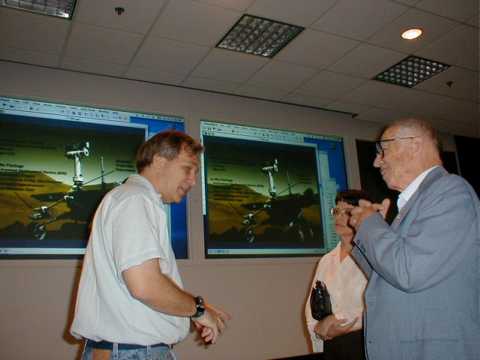Search this Site







Roving Around Mars
By Steve Bartlett
Two robotic explorers are on their way to the Red Planet to roam its surface and gather new data on its environment. Built under the Mars Exploration Rover (MER) program, the rovers will land in January of 2004, according to Dr. Mark Adler of the NASA Jet Propulsion Laboratory in Pasadena. Adler, the Deputy Mission Manager of the MER program, briefed an OASIS audience on September 27 in his talk “Roving Around Mars.”
The MER craft, dubbed “Spirit” and “Opportunity,” were launched aboard Delta II rockets in June and July, respectively. Adler’s talk featured a detailed computer simulation showing the launches, the rovers’ cruise to Mars, their eventful arrival and landing, and their deployment at the landing site. The robots will fly directly to the planet without going into orbit. They will approach Mars at high velocity and slow down using a combination of heat shield, parachute, rockets, and airbags. The Spirit rover will land in the Gusev Crater, while the Opportunity rover will touch down in the Meridiani Planum.
 |
| Dr. Mark Adler talks to OASIS members after his lecture. |
Dr. Adler showed the crowd details of the rovers’ instruments, including their multispectral sensors, which will allow researchers to determine the chemical compositions of rocks simply by looking at them. The vehicles also feature rock abrasion tools, a microscope to examine specimens, a panoramic camera, Mossbauer and Alpha particle X-ray spectrometers, and magnet arrays.
His talk described how the mission crew on Earth will guide the craft, determining where it will go, what rocks and surfaces it will examine, and what sensors to use and when. One problem the mission planners will encounter will be adjusting their personal work and sleep schedules to the constraints of the 24 hour and 40 minute Martian day. That 40 minute difference between the Mars day and a day on Earth will force the crews to adjust their wake/sleep cycles by that amount each day.
The rovers will be able to travel more than a kilometer from their landing sites, considerably further than the few tens of meters that the Mars Pathfinder rover roamed in 1997. To accomplish this, the rovers have larger wheels, solar arrays and considerable autonomy. This autonomy will allow controllers to tell the rover in general terms where to go and the rover will select its path and navigate there while avoiding obstacles along the way.
The tight space constraints within the Delta II’s nosecone imposed some difficult packaging problems for the MER design team and drove them to a rover configuration that folded up tightly for launch and cruise and then performed an elaborate, articulated deployment upon landing. The MER rovers fit within the same launch envelope as the small Mars Pathfinder rover but, when deployed, are over four times larger than the Pathfinder vehicle.
Besides being the Deputy Mission Manager for MER, Adler is the Mission Manager for the Spirit rover. He was responsible for the development, test, and training of the MER operations system before the launches, and the MER mission design including trajectories, navigation, mission planning, launch vehicle targeting, and entry-descent-and-landing simulations. He was also the Project Landing Site Engineer, responsible for the landing sites selection. Prior to MER, Adler worked on the Mars Sample Return program and the Cassini program.
Copyright © 1998-2005 Organization for the Advancement of Space Industrialization and Settlement. All Rights Reserved.